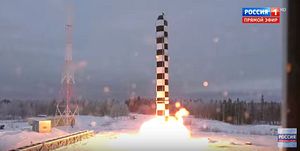Russia has been testing its deadliest nuclear weapon currently under development, the super-heavy thermonuclear-armed intercontinental-range ballistic missile (ICBM) RS-28 Sarmat (NATO designation: SS-X-29 Satan 2), Russian President Vladimir Putin announced during his annual State of the Union address on March 1.
“We have launched the development of the new generation of missiles, and, in particular, the Defense Ministry jointly with the missile and space industry launched the active phase of tests of a new missile complex equipped with a heavy intercontinental missile. We called it Sarmat,” Putin said, according to TASS news agency.
A video released during the Russian president’s speech appears to confirm that a much anticipated ejection test — which tests the mechanism of a missile leaving its launch container — has taken place. The launch (there is ongoing speculation about the precise nature of the test) apparently occurred in December 2017 at the Plesetsk space center, located in Arkhangelsk Oblast, approximately 800 kilometers north of Moscow.
The December 2017 test is only the second test of the Sarmat ICBM. “So far, we know of one single test of the new weapon system. In August 2016, the Sarmat’s first stage engine, named PDU-99, was tested. Analysts believe that the engine is a modified version of the RD-274 liquid rocket engine used on the RS-36M ICBMs. However, it is unclear whether the test was successful or not,” I reported in January 2017.
The Sarmat is expected to enter service by 2020, replacing Soviet era RS-36M Voyevoda
ICBMs, which have constituted the backbone of Russia’s silo-based strategic nuclear forces for the past 25 years. However, the program has encountered multiple delays and it is highly unlikely that the missile will be operational by then.
Some of the delays in testing were “due to the unpreparedness of the silo-based launcher,” according to Russian media reports.
“With the total weight of over 200 tons it has a short active flight path, which complicates its intercept by ABM systems,” Putin said on March 1. “The new heavy missile’s range, the number and yield of its warheads are greater compared to the Voyevoda missile.” The new ICBM will reportedly be twice as light as the Voyevoda.
As I explained last year:
The Sarmat can reportedly carry 10 heavy or 15 (some sources say 16) lighter warheads. The new ICBM can allegedly also be fitted with a new hypersonic glide vehicle (HGV), the YU-71, currently in development under the secret Project 4202. (…) The YU-71 is a warhead purportedly capable of penetrating any Western missile defense system. (…) Each warhead [allegedly] has an explosive yield of up to 750 kilotons.
In his address, Putin noted that a new HGV has purportedly entered serial production. “I can tell you that we have all this already and it works well. Moreover, Russia’s industry has begun to batch-produce this system. It is yet another type of strategic weapon at Russia’s disposal,” he said. “We’ve called it Avangard.” The Yu-71 and Avangard appear to be one and the same system.
Additionally, the Russian president noted:
New composite materials have allowed for coping with the problem of keeping the winged vehicle under control during a prolonged flight amid plasma. In fact, while approaching the target it looks like a meteorite. A fireball. The temperature on its surface may reach 1,600-2,000 Celsius. Control of the winged vehicle remains reliable all the way.
In October 2016, the Makeyev Rocket Design Bureau posted a declassified picture of the Sarmat on its website for the first time. The ICBM is being built by the Krasnoyarsk Machine-Building Plant.
































